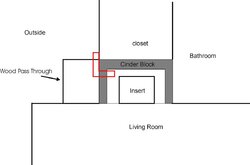Attached is a drawing of my fireplace and the wood pass through that sits next to it. I have decided on the PE Summit insert. I'm trying to figure out the best way to provide outside combustion air to the stove. The following paragraph is from the PE Summit manual
Outside air supply: Remove cover from ash clean out in existing fireplace. Place a rodent screen in place of the cover. Install the Insert as described in the "Installation" section, making sure not to cover the opening of the air inlet. When installation is complete, seal surround to fireplace and anywhere else air may enter. This will ensure combustion air is drawn from the outside of the house and into the 9" x 2" intake at the lower rear of the appliance.
Since I don't have an ash clean out, can I cut a small hole in the cinder block of the fireplace and then a small hole in the outside door of the pass through, and then build a duct like i have shown in the drawing? If I do this will I still be able to place wood in the pass through? Also how big of a duct do I need? The above paragraph mentions a 9" x 2" intake at the lower rear of the stove. So, am I safe in assuming I would need 18 square inches of opening? Also, there is no mention of connecting this to the stove. Does the stove just pull air in from the back of it and the hole replaces that air?
Outside air supply: Remove cover from ash clean out in existing fireplace. Place a rodent screen in place of the cover. Install the Insert as described in the "Installation" section, making sure not to cover the opening of the air inlet. When installation is complete, seal surround to fireplace and anywhere else air may enter. This will ensure combustion air is drawn from the outside of the house and into the 9" x 2" intake at the lower rear of the appliance.
Since I don't have an ash clean out, can I cut a small hole in the cinder block of the fireplace and then a small hole in the outside door of the pass through, and then build a duct like i have shown in the drawing? If I do this will I still be able to place wood in the pass through? Also how big of a duct do I need? The above paragraph mentions a 9" x 2" intake at the lower rear of the stove. So, am I safe in assuming I would need 18 square inches of opening? Also, there is no mention of connecting this to the stove. Does the stove just pull air in from the back of it and the hole replaces that air?


